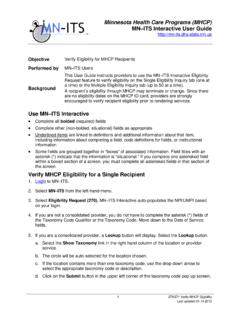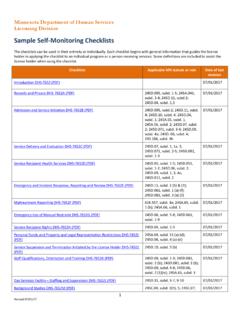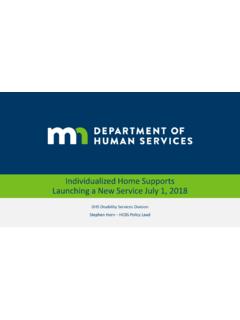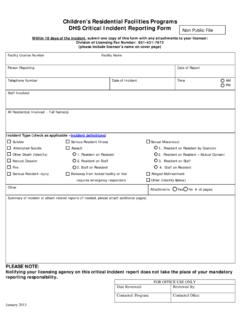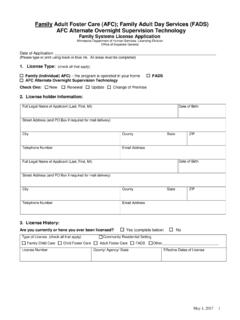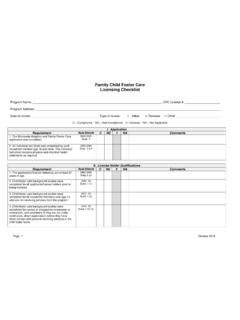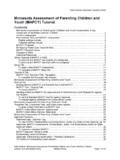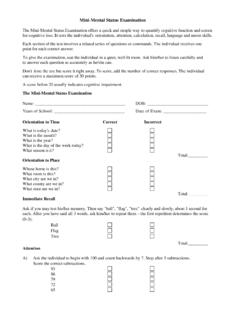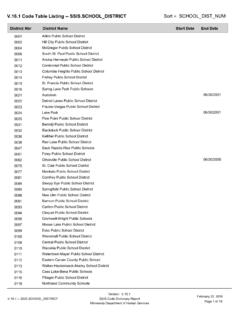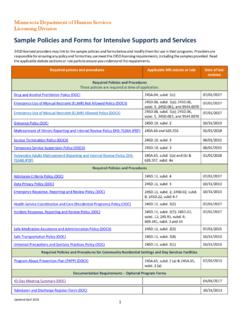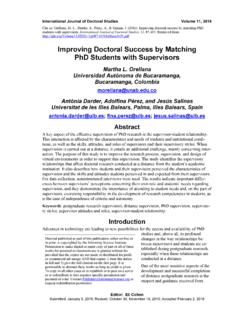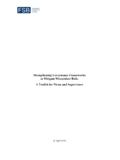Transcription of Child Protection Program Logic Models for Supervisors
1 Child Protection Program Logic Models for Supervisors Background Minnesota was one of the first states to participate in the federal Child and Family Service Reviews. The review uses multiple sources to assess a state s performance on a series of measures that examine the outcomes of Child safety, permanency and well-being and the state s strengths and needs. Following the completion of the review, the state is required to develop a Program Improvement Plan (PIP) describing in detail its strategies for addressing specific outcome needs. One of the strategies in the state s Program improvement plan was to develop a guide for Supervisors which focused on best practice in quality assurance. The Child Protection Program Logic Models for Supervisors were developed by department staff with an advisory group of county Supervisors . Program Logic Models A Logic model provides a road map of how a specific Program is expected to work, what activities need to come before others and how desired outcomes are achieved.
2 A Logic model includes inputs, activities, outputs, outcomes and a Program theory. Inputs: The internal and external resources used by the county Child Protection system to achieve Program objectives. Activities: The consultation and quality assurance actions of a Child Protection supervisor , using the inputs provided, to achieve positive results for children and families served by the agency. Outputs: The products that result from an effective use of resources by Child Protection agency staff. Two types of outputs are used in these Logic Models : the 23 Child and Family Service Review performance indicators used to measure safety, permanency and well-being, and performance measures more specific to Child Protection in Minnesota. Outcomes: The ultimate benefits experienced by the children and families served by the agency. These benefits are organized under the three domains: safety, permanency and well-being. Program Theory: If - Then statements have been constructed for each of the Child Protection Logic Models to describe the Program rationale or hypotheses.
3 They attempt to identify some of the critical links in the chain of reasoning specific to each Program model . Key Decision Points The fundamental purpose of Child Protection Program Logic Models is to promote effective decision making in key areas. Core questions need to be addressed in each of the principal Child Protection Program areas. Screening < Does the agency accept the report for investigation? If so, what level of response is indicated? < What reports should be assigned for traditional assessment and what reports should be assigned for an Alternative Response? < Which reports, not accepted for assessment, should be referred for voluntary Child welfare services or receive no agency response? Assessment < Is the Child safe and what actions are necessary to ensure the Child s safety? Case Management < What changes are needed to promote Child safety and reduce future risk of maltreatment? < What results are needed to either increase or reduce Child Protection service intensity?
4 < When should Child Protection involvement end? < Was permanency established in a timely and appropriate manner? Child Protection Program Logic Models for Supervisors : These Program Logic Models present specific Program overviews. These are not all of the inputs, activities, outputs and outcomes of a Program area. Rather, the Models guide discussion among county Child Protection personnel. Counties are encouraged to expand upon these Models and make them more applicable to the needs of their clients and agency. The process of developing a Program Logic model is intrinsically valuable and advances a broader understanding of the overall purpose of Child Protection . Additionally, these Models support the following underlying social work principles: < Family-Centered Practice < Community-Based Services < Strengthening Parental Capacity < Individualized Services. These principles are consistent with social work practice that form the foundation of the Child and Family Service Reviews.
5 A county agency could use these Program Logic Models as: < A tool to provide new staff with an overview of each Child Protection Program and demonstrate how these programs are integrated and designed to address core Child Protection decision points. < An approach to identifying and evaluating the effectiveness of both agency resources and external community resources. < A structure for identifying agency Child Protection outputs or products and creating a responsive quality assurance system that reinforces consistent and high quality service delivery. < A method of clarifying desired Program outcomes and identifying data sources that serve as accurate outcome measures. < A guide for directed case consultation, with emphasis on best practice for quality assurance. Data Collection The collection and interpretation of data is critical in evaluating the usefulness of programs and the achievement of outcomes. The Child Protection Logic Models for Supervisors use the Social Service Information System reports and relevant county generated data.
6 Specific reports are identified within each of the Logic Models and are designed to provide useful outcome data for Supervisors in measuring and monitoring Child Protection Program areas and individual worker performance. Child Protection Screening INPUT ACTIVITIES OUTPUTS OUTCOMES Agency Resources < Number and quality of agency screening staff < Availability and quality of supervisory staff < Staff training < SDM tools - priority response and safety tools - AR screening tool. < 24-hour Child Protection response capacity < Agency screening team and protocols < Screening guidance: < MN Statutes < MN Rules 9560 < Local screening criteria < Orientation and training activities Agency Partners < Law enforcement < Mandated reporters < Community at large < Other Child Protection agencies, state and national < DHS: SSIS, MCWTS and other programs within the Child Safety and Permanency Division < Tribal social services Consultation < Accurate screening decisions < Responsiveness to community needs, , telephone and face-to-face contacts in a timely, respectful and professional manner Key Questions < Were family strengths, service delivery challenges and best practices identified and discussed?
7 < What is the agency s policy regarding time frames for screening and recording Child Protection reports , telephone contacts during work hours, face-to-face contact during work hours and after hours contacts? < Has the agency established clear expectations regarding the thoroughness, accuracy and overall quality of recorded intakes with adequate consideration of ICWA, domestic violence, substance abuse and client disabilities? < Are screeners using additional resources to collect collateral information concerning a report ( , from police, schools, medical professionals, agency records, and other community sources) before making a final screening decision? < Are mandated reporters and others satisfied with the agency s response to their reports of Child maltreatment? CFSR Performance Indicators Item 1 Initiation of investigation of reports of Child maltreatment is consistent with state policy. Item 4 Risk of harm is managed through appropriate interventions.
8 Other Performance Indicators < Screening decisions are consistent with state and local screening criteria < Reports, both accepted and not accepted for assessment, are recorded in SSIS Safety S1 Children are first and foremost protected from abuse and neglect S2 Children are safely maintained in their homes whenever possible Child Protection Screening Quality Improvement Components Program Theory If: < Child Protection screening staff gather comprehensive, relevant and accurate information from reporters < Child Protection staff consistently record this information in SSIS < Screening decision makers have full access to this information < Screening decisions are made consistent with statutory guidelines, local screening criteria related SDM protocols Then: < Cases of alleged maltreatment identified in the community will be appropriately assigned for either traditional assessment, Alternative Response assessment or a voluntary Child welfare response.
9 Key Decision Points < Does the agency accept the report for assessment? If so, what level of response is indicated? < What reports should be assigned for traditional assessment versus Alternative Response? < What reports not accepted for Child Protection assessment should be referred for voluntary Child welfare services or receive no agency response? Case Record Review < Monitor timeliness of recording and transferring accepted reports from screeners to assessment workers. < Review individual intake records for quality and compliance purposes. < Ensure that cross reporting to law enforcement occurs consistently. < Review a percentage of referrals accepted for assessment for quality of decision making and documentation. < Review a percentage of referrals not accepted for assessment for quality of decision making and documentation. < Review agency decisions to respond to reports, not accepted for a maltreatment assessment, with a Child welfare response when indicated.
10 < Ensure that American Indian children are identified promptly. < Ensure that mandated reporters receive agency letters explaining why a Child maltreatment report was not accepted for investigation. SSIS Reports < Intake Log < Detailed Intake Statistics by Program area < Intake allegations by CP track < New in CP Activity Traditional Child Maltreatment Assessments INPUT ACTIVITIES OUTPUTS OUTCOMES Agency Resources < Number and quality of agency CP assessment staff < Availability and quality of supervisory staff < Staff training < Capacity for culturally competent response < Statutory guidance: < MN Statutes < MN Rules 9560 < SDM tools: safety and risk assessments < Overall county children s services array Agency Partners < County law enforcement < County attorney < County Child Protection team < Community collateral contacts - schools, medical and other service providers < Emergency Child care providers < Other Child Protection agencies, state and national < Tribal social services Consultation < All accepted reports and contents with assigned assessment worker < Families were treated respectfully and their strengths and needs fully explored < CP decisions.
